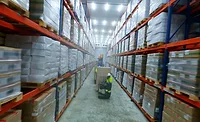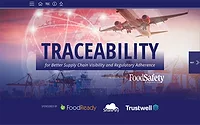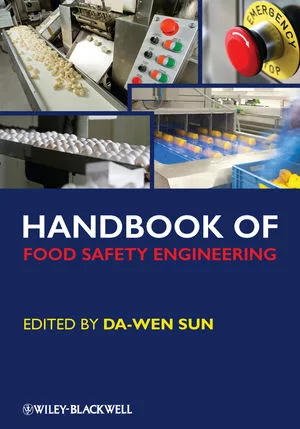Better Food Traceability Can't Wait
Progress is being made, and we need to keep the momentum going

Video credit: simonkr/Vetta via Getty Images
Roughly five years ago, while serving as Deputy Commissioner for Food Policy and Response at the U.S. Food and Drug Administration (FDA), I sat down with NBC News for an interview on the effectiveness of the federal government's ability to respond to and prevent foodborne outbreaks.
When the piece aired, it included the tragic details of a three-year-old child who, in 2018, suffered permanent brain damage and can no longer talk, walk, or see after sharing a salad with his father that was contaminated with Escherichia coli O157:H7 during a family vacation. During this outbreak, FDA was unable to trace back to source where the contaminated leafy greens originated from and, as a result, issued an advisory for consumers nationwide to avoid all romaine lettuce, regardless of where it was grown or produced.
I told NBC then—and it remains true today—that there is more the industry and regulators can and must do to improve food traceability. That is why, in November of 2022, while I was still at FDA, we issued the Final Food Traceability Rule. The food industry now has until January 2026 to comply with that rule.
An Idea Whose Time Has Come—And is Overdue
As a reminder, it was Congress that passed the Food Safety Modernization Act (FSMA), in a bipartisan manner, in 2011 and President Obama who signed it into law. As part of FSMA, Congress specifically directed FDA to develop a Food Traceability Rule,1 referred to as Section 204, that requires producers of certain foods to enhance food traceability recordkeeping requirements and data-sharing capabilities in the midst of an outbreak investigation.
It has been 13 years since FSMA was signed into law. Since that time and, as recent as this past year, we have seen time and time again why Congress had it right—the need for better food traceability capabilities can't wait.
To illustrate just how long this journey has taken, many readers may recall an outbreak of E. coli O157:H7 in the U.S. in 2006 that resulted in all spinach produced in the U.S. being pulled from grocery store shelves. That outbreak served as a wakeup call for the nation on the need for better traceability within the food system. Fast forward to the fall of 2018, in the outbreak I described above, and it is clear that not much had changed over those 12 years.
Unfortunately, as recently as this past year, the slow response and outcomes of several foodborne outbreaks continue to remind us that our abilities to rapidly trace foods have not significantly improved or kept up with the pace of digital modernization that has happened in the world around us. For example, in an incident revealed late last year, the U.S. Centers for Disease Control and Prevention (CDC) reports that over 500 children nationwide have experienced lead poisoning after consuming cinnamon-flavored applesauce pouches contaminated with the heavy metal. In this tragic incident, after FDA was initially made aware of the problem by the good work of health officials in the state of North Carolina, contaminated applesauce pouches were still being sold on store shelves approximately one month after the initial recall. Health officials could not pinpoint with speed, nor specificity, the source of the lead-contaminated ingredient, cinnamon spice, due to an inability by the industry and regulators to conduct effective traceback and trace-forward activities in the midst of a foodborne crisis.
Looking for quick answers on food safety topics?
Try Ask FSM, our new smart AI search tool.
Ask FSM →
Progress is Being Made
There is good progress being made by industry, but things are changing, and we need to keep the momentum going.
Until recently, there had not been a widely adopted regulatory standard for what and how each segment of the food system should track and record data for food traceability purposes. Therefore, the current system had been limited to traceability capabilities that were often described as "one step forward and one step back," without much specificity.
FDA's Final Food Traceability Rule is changing that, and we are now seeing more progress being made on food traceability in the past year alone, than we have over previous decades. The breakthroughs that are occurring are primarily due to the main components of the rule. They include the establishment of Key Data Elements (KDEs), Critical Tracking Events (CTEs), Food Traceability Lot Codes, as well as a Food Traceability List (FTL)2 for which these additional record-keeping requirements will apply. I have personally described the establishment of these standards as the equivalent of creating a universal language of food traceability.
The rule also requires covered food entities to be able to provide required food traceability records to FDA, if requested, within 24 hours. This will allow FDA and food companies to quickly identify and remove contaminated food from the market, in turn preventing foodborne illnesses.
It is Worth it and Needed
The benefits of a more traceable food system are obvious. However, I want to be clear: It is so much more than mere containment.
First, being able to trace a contaminated food to its source in the midst of an outbreak allows a culprit food to be identified earlier in an epidemic curve, allowing the food to be pulled from commerce, thereby preventing additional illnesses. This is a form of prevention, albeit secondary prevention. In addition, it enhances our ability to needlessly affect the livelihood of food producers whose products are unaffected.
Second, enhanced traceability allows public health officials to identify an affected food product involved in outbreak sooner, thereby allowing a more timely and relevant root cause investigation to take place that could strengthen our ability to prevent future, similar, recurring outbreaks. Again, this would also strengthen prevention.
And lastly, better food traceability ultimately results in greater transparency. Numerous behavioral science studies have shown us just how powerful a force transparency is to inhibiting undesired behaviors and influencing conformance to more desired behaviors and outcomes.
The Cost of Doing Nothing is Too High
The cost of food safety lapses has never been higher. In fact, a cost-benefit analysis of FDA's Final Food Traceability Rule demonstrated that there is a favorable return on investment, from a public health perspective alone, on better food traceability. When other features are considered, such as the potential to enhance supply chain efficiencies, reduce food waste, and improve sustainability, the public health and business case are undeniable.
Keep the Momentum Going
Every week, I talk to food companies big and small, and I applaud them for the progress they are making to comply with FDA's Food Traceability Rule by January 2026. While various strategies are evolving in how to collect and share the Key Data Elements and Traceability Lot Code information required by the rule, whether you choose a low-tech or high-tech approach is up to you. One trend that is apparent (which we always anticipated when we wrote the rule) is that companies that are already leveraging or adopting GS1 consensus standards to better enable commerce (such as GLNs, GTINs, SSCCs, and GS1-128s) that contain required KDEs embedded in 1D or 2D barcode labels, or smarter data carries (such as RFID or ambient IoT pixels) are finding compliance to be a lot easier than originally thought.
Encouragingly, while there is a lot of great work already occurring across the country behind the scenes, as January 2026 is rapidly approaching, some companies are already sharing plans on how they will comply and communicating those requirements to their suppliers. In one bold move, one major retailer in the U.S., Kroger, has already shared that it will require its suppliers to provide it with the required food traceability data attributes via GS1 standards.3 Kroger will also require this information for all foods—not just foods on FDA's Food Traceability List.2 The retailer has also shared that it expects its suppliers to comply by July of 2025, six months sooner than the Food Traceability Rule's compliance date. I suspect other similar announcements are likely to be forthcoming.
As is the case with all meaningful progress, there will always be a few entities that will be critical and resist change. However, now is not the time to stop, be distracted, or slow things down. We are making too much progress, we have too much momentum, and consumers deserve and expect us to be able to promptly trace foods to source during a foodborne illness crisis.
In closing, remember that better food traceability can't wait. Our ability to provide safe, affordable, and sustainable food for this generation and the next depends on it.
References
- U.S. Food and Drug Administration (FDA). FSMA Final Rule on Requirements for Additional Traceability Records for Certain Foods. November 2022. https://www.fda.gov/food/food-safety-modernization-act-fsma/fsma-final-rule-requirements-additional-traceability-records-certain-foods.
- FDA. Food Traceability List. Current as of March 20, 2024. https://www.fda.gov/food/food-safety-modernization-act-fsma/food-traceability-list.
- Food Safety Magazine. "Kroger’s Traceability Policy Goes Beyond FSMA 204 by Including All Foods." March 18, 2024. https://www.food-safety.com/articles/9322-krogers-traceability-policy-goes-beyond-fsma-204-by-including-all-foods.
Frank Yiannas, M.P.H., is a food safety leader and food system futurist, author, professor, and former food safety executive at global brands. He also served as the Deputy Commissioner of Food Policy and Response at the U.S. Food and Drug Administration (FDA) from 2018 to February 2023. While at FDA, he was instrumental in creating the New Era for Smarter Food Safety blueprint and many other initiatives related to the implementation of FSMA. He has also held food safety leadership roles with Walmart and the Walt Disney Company. Additionally, he advanced global thinking on food safety culture with his pivotal 2008 book, Food Safety Culture: Creating a Behavior-Based Food Safety Management System. Mr. Yiannas has long been recognized for his role in elevating food safety standards and building food safety management systems based on science and risk.









